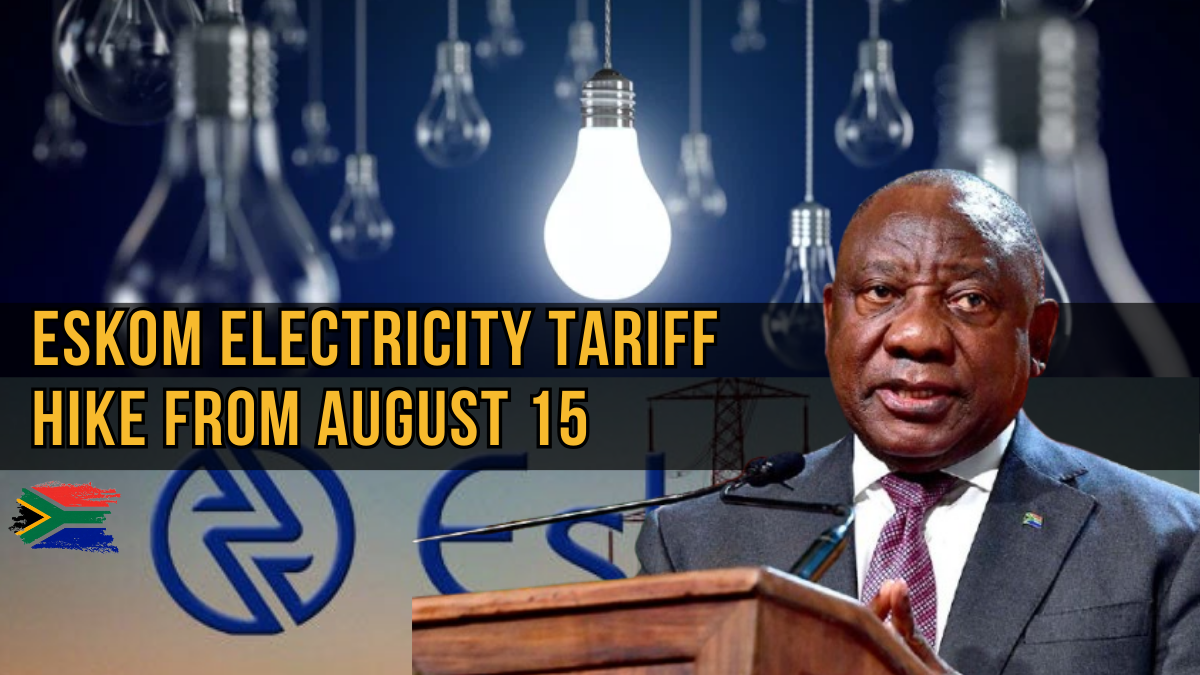From August 15, 2025, South Africans will pay more for electricity as Eskom’s latest tariff hike comes into effect. The increase, ranging from 5% to 7% depending on the province, will impact households, businesses, and public institutions already under financial pressure from rising living costs and ongoing load shedding.

This detailed report provides a full provincial breakdown, explains why Eskom is raising prices, and offers practical tips to help consumers reduce the impact on their monthly bills.
Summary Table: Eskom Tariff Hike August 15
Field |
Details |
|---|---|
Tariff Hike Date |
August 15, 2025 |
Average Increase |
5% to 7% depending on province |
Highest Increase |
KwaZulu-Natal (+7%) |
Main Reason |
Operational cost recovery & infrastructure upgrades |
Impacted Groups |
Households, businesses, public institutions |
Coping Strategies |
Energy audits, efficiency upgrades, solar adoption |
Official Website |
Understanding the August 15 Eskom Price Hike
Eskom’s tariff adjustment is not uniform nationwide. Instead, rates vary based on provincial infrastructure demands, energy supply costs, and local consumption patterns.
For residential users, the price hike will result in an estimated 5% to 7% increase in monthly electricity bills. While that percentage may seem small, it’s a significant strain when combined with other rising costs such as food, fuel, and housing.
Provincial Breakdown of New Electricity Rates
Province |
Estimated Increase |
Approximate Cost per kWh |
|---|---|---|
Gauteng |
+5% |
R1.26 |
Western Cape |
+6% |
R1.32 |
KwaZulu-Natal |
+7% |
R1.39 |
Eastern Cape |
+6.4% |
N/A |
Free State |
+5.7% |
N/A |
Mpumalanga |
+5.7% |
N/A |
Northern Cape |
+5.5% |
N/A |
North West |
+5.9% |
N/A |
Limpopo |
+5.9% |
N/A |
Why the variation?
Distribution costs, infrastructure maintenance needs, and regional consumption patterns all contribute to the differences in provincial rates.
Why Eskom Is Increasing Prices
Eskom cites multiple reasons for the August 15 tariff increase:
- Recovering operational and maintenance costs for aging infrastructure.
- Investing in grid upgrades to reduce breakdowns.
- Reducing load shedding by improving generation capacity.
- Funding renewable integration for long-term energy security.
However, critics highlight mismanagement, corruption, and delays in investment as underlying issues that continue to push costs onto consumers.
How the Price Hike Will Affect Different Sectors
1. Households
- Lower-income families will have to cut back on appliance use and heating.
- Prepaid customers will get less electricity for the same spend.
2. Businesses
- Retail, hospitality, and manufacturing sectors will face higher operational costs.
- Many small businesses may pass these costs onto consumers.
3. Public Institutions
- Schools, clinics, and community centers will need to adjust budgets, possibly impacting service delivery.
Practical Strategies to Reduce Electricity Costs
If you want to mitigate the impact of the tariff hike:
- Conduct an energy audit to identify high-consumption appliances.
- Switch to energy-efficient devices like LED bulbs and inverter appliances.
- Install solar power—even partial systems like solar geysers can help.
- Use appliances strategically during off-peak hours.
- Monitor usage with prepaid meters or smart plugs.
The Growing Case for Renewable Energy
The tariff hike strengthens the argument for renewable adoption:
- Solar power is becoming more affordable, especially with government tax incentives.
- Over time, renewables can shield households and businesses from Eskom’s price volatility.
Frequently Asked Questions (FAQs)
Q1. When will the new Eskom tariffs take effect?
Ans. From August 15, 2025, across all provinces.
Q2. Why are rates different in each province?
Ans. Due to variations in distribution costs, infrastructure needs, and consumption patterns.
Q3. How much more will I pay?
Ans. Most residential users will see 5% to 7% increases on monthly bills.
Q4. Can I avoid the increase?
Ans. No, but reducing consumption and using energy-efficient devices can help.
Q5. Will this stop load shedding?
Ans. Not immediately, but Eskom says increased revenue will support infrastructure upgrades to reduce outages over time.
Final Thoughts
The Eskom tariff hike from August 15, 2025, will impact all sectors, but proactive energy management can help reduce its effect on monthly budgets. Consumers are encouraged to adopt efficiency measures and explore renewable energy options to protect themselves against future increases.
For More Information Click Here